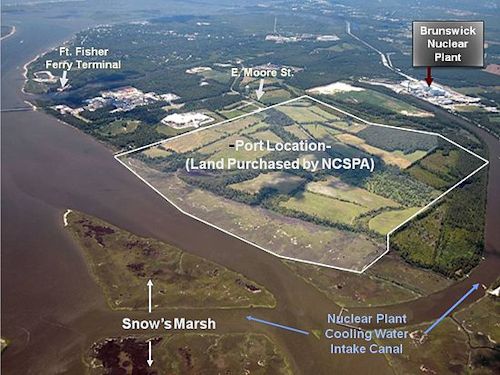SOUTHPORT — More than 600 acres of old farming fields and woodlands stretching 4,000 feet along the Cape Fear River was just what the N.C. State Ports Authority needed to begin fulfilling the vision of a mega-port in southeastern North Carolina for large container ships.
The land was the right size and location.
Supporter Spotlight
 Tom Eagar |
So, when word got to Tom Eagar, the authority’s chief executive officer at the time, that pharmaceutical-giant Pfizer put the land up for sale, he wasted no time setting in motion plans to buy the property.
Much has changed during the six years since the authority borrowed $30 million to buy the land near Southport in Brunswick County.
The N.C. International Terminal is now a pipe dream, and the land now isn’t worth anything near what the state paid for it.
Eagar, the mega-port’s biggest advocate, was relieved of his position in January by the head of the N.C. Department of Transportation.
Staunch opposition from residents and politicians have ultimately halted the proposed $2 billion project, leaving the authority with land some say wasn’t worth the price and may not be environmentally suitable for the type of industrial development being considered.
Supporter Spotlight
After acquiring land along the Cape Fear River in Brunswick County in the early 1970s, Pfizer built a citric acid plant on the property in 1976.
When citric acid, a natural preservative, was made, it produced a yeast-cream slurry, which was applied to the land.
The state issued Pfizer a non-discharge permit to apply up to 40,000 gallons per-day of the sludge onto the land, according to an assessment of the site. The assessment process is intended to determine the environmental characteristics of a piece of commercial real estate, giving a potential buyer the most basic details about a property.
An environmental assessment or a more in-depth environmental impact statement are meant to determine how development may affect the environment. The studies are required by law when a government entity plans a major development, but only before construction begins. However, if land purchases are made to build major new infrastructure then an environmental review or impact statement is normally prepared. But neither was done for the port site.
The authority hired Catlin Engineers and Scientists in Wilmington to conduct the site assessment in 2005. The firm’s report was based solely on a paper trail of state documents, photographs and interviews of locals and former Pfizer employees familiar with the land.
 The 600-acre tract that the N.C. State Ports Authority bought for a proposed new container port may no longer be worth what the state paid for it. |
Caitlin was not granted physical access to the property. In the assessment, the engineering firm recommended the authority conduct a second assessment for “visual site and vicinity reconnaissance.”
How the authority followed-up on that recommendation remains unclear.
An authority spokesperson did not respond to requests for interviews.
The Caitlin report describes the acreage as generally flat. Four ponds are on the property. Wetlands cover the eastern portion of the land. The rest is undeveloped woodlands.
The report notes that there’s a “potential for environmental concern” because of the sludge generated from the citric acid production.
The land was broken into two parcels, the first of which spans a little more than 227 acres. At the time of the study, its tax value was $3.23 million. The second and larger parcel with 402 acres carried a value of $1.63 million, according to Brunswick County tax records.
Those figures have led to questions about why the authority agreed to pay $30 million for the property.
When the authority purchased the land in 2006, it was at the height of the real estate boom.
Hansen Matthews, a commercial real estate broker and co-founder of The Maus, Warick Matthews & Co. Team in Wilmington, was not involved in the authority’s purchase of the land, but he is familiar with the real estate market in Brunswick County.
“The market crested around 2006,” Matthews said. “Almost any price paid at the time was top-dollar.”
The Pfizer tract was the only one of that size available along the Cape Fear River at that time, Matthews said.
“It’s hard to get 20 acres of river frontage in Brunswick County,” he said. “Either they bought that one or just give up on the idea.”
The property’s tax value has increased to $12.7 million, but, if the authority put the land on the market today, it would not likely recoup enough money to pay its debt on the land.
The market for raw land in Brunswick County has plummeted since the mid-2000s, Matthews said.
To get an indication of just how far the market has dropped, Matthews’ firm is handling the sale of a 583-acre tract between Bolivia and N.C. 211 in Brunswick County. That parcel sold for $9 million at the height of the market in 2006. It’s up for sale today with an asking price of $1.3 million.
Another tract, this one more than 400 acres of partially developed land at the intersection of U.S. 17 and Cumbee Road, sold for $8 million in 2006. It’s on the market for $1.75 million.
“We’re on the bottom of the market,” Matthews said. “We’ve been bumping the bottom all year long. If [the authority] takes that land to the market now they’re going to be creamed.”
Plans for the land remain up in the air. The authority may use the site to build a container port, an option noted in the N.C. Maritime Strategy Final Report. Save the Cape, a volunteer group in Wilmington, would like to see the land become part of a national seashore in the lower Cape Fear River.
The authority has not publicly discussed the report since its release in June.







